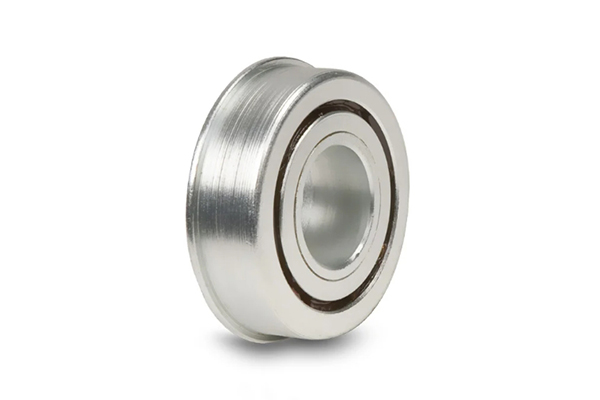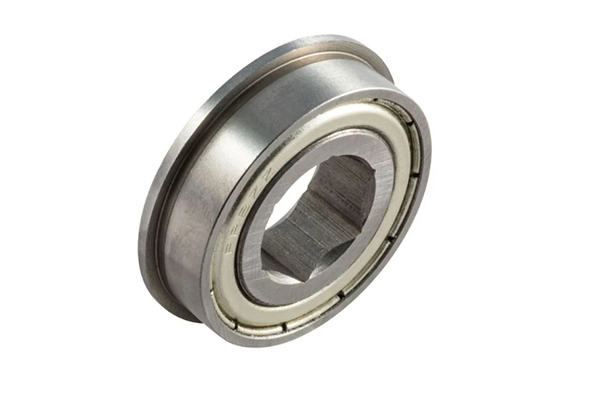
Flanged Ball Bearings Needed? A Comprehensive Guide to Selecting the Right Flange Bearing
2025-07-23
If you’re in the business of manufacturing equipment, you know that every component counts. The humble bearing is often the unsung hero, ensuring smooth and efficient rotation. But what happens when your design requires a simpler, more secure mounting method? This is where the flanged ball bearing comes in. As a factory owner, I’ve seen countless engineers and procurement managers like you, Mark, grapple with component selection. This guide is born from that experience. We’ll dive deep into the world of the flange bearing, exploring what it is, when to use it, and how to select the right one to avoid common pitfalls like production delays and quality mismatches. This article will give you the confidence to make the best purchasing decisions for your machinery.
What Exactly is a Flange Bearing and How Does It Work?
At its core, a flange bearing is not a new type of bearing technology. Instead, it’s a clever and highly practical modification of a standard ball bearing. Imagine a regular ball bearing; now, picture a small lip or "flange" extending from the outer race. This flange is the key feature. Its primary job is to act as a locating mechanism, much like a collar on a shaft. When the bearing is inserted into a housing bore, the flange rests against the face of the housing, preventing the bearing from moving axially through the bore.
This simple design element revolutionizes the mounting process. With a standard unflanged bearing, you often need to machine a precise shoulder or "counterbore" inside the housing to stop the bearing. This requires extra machining steps, which adds time and cost. The flange bearing eliminates this need. It allows for a straight, through-bored housing, which is simpler and cheaper to manufacture. The bearing is simply slid into place until the flange sits flush, providing a secure and perfectly aligned fit.
When Should You Choose a Flange Bearing Over a Standard Unflanged Bearing?
The decision between a flanged and an unflanged bearing often comes down to a flanged design simplifying the machine design and assembly. If you’re looking to streamline your production line, the use of a flanged bearing is a strong consideration. They are commonly used when the application requires easy and secure axial positioning without complex housing modifications. Think of applications with thin housing walls where machining a proper shoulder for a press-fit is impractical or would weaken the structure.
Furthermore, in applications where there’s a need to mount a bearing on the surface of a plate rather than inside a bore, a two- or four-bolt flange bearing unit is ideal. However, for the single-lip style we’re discussing, the primary driver is ease of mounting and positive location. The choice becomes clear when your design engineer prioritizes faster assembly and reduced machining costs. The need for a flanged bearing is most apparent when you want to lock the bearing in place along the shaft‘s axis without relying solely on an interference fit.

What Are the Key Advantages of Using a Flange Bearing?
The benefits of incorporating a flange bearing into your design are significant and directly impact your bottom line. As a business owner, these are the points that often resonate most with my clients.
- Simplified Housing Design: The most prominent advantage is the elimination of the need for a counterbore or shoulder in the housing. A simple, straight-through bore is sufficient, which reduces machining complexity and cost.
- Faster and Easier Assembly: Installing a flange bearing is incredibly straightforward. The installer can simply press the bearing into the housing until the flange is seated. This reduces assembly time and minimizes the chance of installation errors, like pressing the bearing in too far.
- Secure Axial Location: The flange provides a positive stop, ensuring the bearing is precisely positioned and locked in place axially. This is particularly beneficial in a high vibration area or where thermal expansion and contraction might otherwise cause a press-fit bearing to shift.
- Improved Alignment: Because the flange seats squarely against the housing face, it helps to ensure the bearing is properly aligned perpendicular to the shaft. This reduces the risk of premature wear caused by misalignment and excessive friction.
Are There Any Drawbacks to a Flange Bearing I Should Know About?
While the flange bearing offers many advantages, it’s important to be aware of its potential limitations to make an informed decision. No component is perfect for every single situation. The main drawback to consider is the cost. A flange bearing is slightly more complex to manufacture than a standard ball bearing due to the integrated flange, which can marginally increase the cost per unit. While this cost is often offset by savings in machining and assembly, it’s a factor to include in your calculations.
Another consideration is space. The flange itself has a diameter larger than the bearing‘s outer ring, which means it requires more space radially on the mounting surface. In extremely compact designs where every millimeter counts, this extra footprint might be a limitation. It’s rare, but it’s something your design team should verify. Ultimately, the cost increase by selecting a flanged bearing is typically minor and well worth the benefits in the right application.
How Does the Flange Impact the Bearing’s Load Capacity?
This is a common question, and it’s crucial for understanding the proper use of a flanged bearing. It is essential to remember that the flange is primarily a locating device, not a heavy-duty load-bearing surface. The main radial and axial load capacities of the bearing are determined by its internal construction—the size and number of balls, the depth of the raceway groove, and the quality of the materials used. The flange is not designed to handle significant axial (thrust) loads on its own.
That being said, the flange does help in transmitting minor thrust loads from the bearing‘s outer ring directly into the housing structure. This can be an advantage, as it provides a firm backing for the bearing. However, if your application requires the bearing to handle substantial thrust loads, you should not rely on the flange alone. In such cases, a different type of bearing, such as an angular contact bearing or a dedicated thrust bearing, would be more appropriate. The flange ensures the bearing stays put, allowing the core ball bearing to do its job of managing the primary loads.
What Materials and Configurations Are Available for Flanged Bearings?
Just like their unflanged counterparts, flanged bearings come in a variety of materials and configurations to suit different operating environments. As a supplier, we offer a range of options to meet specific customer needs. The selection here is critical for the longevity and performance of the bearing.
| Material | Common Uses & Characteristics |
|---|---|
| Chrome Steel (52100) | The most common material. Offers high hardness, excellent wear resistance, and high load-carrying capacity. Ideal for most industrial applications. |
| Stainless Steel (440C) | Provides good corrosion resistance, making it suitable for washdown environments, food processing machinery, or medical devices. |
| Plastic / Ceramic | Used in highly specialized applications requiring non-magnetic properties, extreme corrosion resistance, or no lubrication. |
Beyond materials, you can choose from several configurations:
- Open: The balls are exposed, allowing for easy lubrication but offering no protection from contaminants.
- Shielded (ZZ): A metal shield on each side protects against larger debris while adding minimal friction.
- Sealed (2RS): A rubber seal on each side offers the best protection against moisture and fine particles but has slightly higher drag.
The choice depends entirely on your operating environment. For demanding jobs, you might even consider specialized components like our I.1600.32.00.C Platform/turntable ring/turntable bearing, which demonstrates how bearing design can be tailored for specific, heavy-duty applications.

What Are the Most Common Applications for a Flange Bearing?
You’ll find that flanged bearings are most commonly used in a surprisingly wide array of machinery and equipment where their benefits truly shine. Their ease of installation makes them a favorite among design engineers across many sectors. Any application where a flanged miniature ball bearing can simplify the design is a prime candidate.
Some classic industrial applications include:
- Material Handling: Conveyor rollers and baggage systems in airports extensively use the flange bearing for quick assembly and reliable performance.
- Robotics and Automation: The precise positioning offered by the flange is critical for the joints and moving parts in robotic arms.
- Office Equipment: Printers, scanners, and copiers use small flanged bearings to guide paper-feed rollers and moving heads.
- Medical Equipment: The flanged miniature ball bearing is required in many diagnostic machines and tools where precision and reliability are non-negotiable. Medical processing and various other sensitive applications benefit from the secure mounting.
- Textile Machinery: The high-speed, repetitive motions in textile equipment make the secure fit of a flange bearing highly desirable.
How Do Environmental Factors Affect the Selection of a Flanged Bearing?
The operating environment is one of the most critical factors in selecting a flanged bearing. Simply choosing the right size is not enough; you must account for temperature, moisture, and vibration to insure long life and durability of the bearing. For instance, applications with high temperatures will also require special consideration. Standard steel bearings and grease are typically rated for up to 120°C. However, in equipment like industrial ovens or under-the-hood applications, temperatures are often around 180°C. In these cases, a flange bearing with high-temperature grease, special seals, and potentially a larger internal clearance is necessary.
Another key factor is thermal expansion. If you have a steel bearing mounted in an aluminum housing, you have a different rate of thermal expansion. As the machine heats up, the aluminum housing will expand more than the steel bearing. A standard press-fit could loosen, but the flange on a flange bearing ensures it remains securely located axially. The presence of materials like water or chemicals will necessitate a stainless steel flange bearing to prevent corrosion. It’s important for the design engineer to consider these factors, as an incorrect choice can lead to premature bearing failure.
What Key Specifications Must a Design Engineer Consider When Selecting a Flanged Bearing?
To avoid the pain points of receiving incorrect parts, clear specification is everything. A good supplier will work with you, but the process starts with a solid request from your engineering team. The design engineer needs to make sure every critical dimension and performance metric is clearly defined. For procurement officers like Mark, having a checklist of these specs is invaluable when communicating with suppliers.
Here are the absolute must-haves for your spec sheet:
| Specification | Description & Importance |
|---|---|
| Bore Diameter (d) | The inner diameter that fits onto the shaft. The most critical dimension. |
| Outer Diameter (D) | The cylindrical outer diameter of the bearing that fits into the housing. |
| Flange Diameter (Df) | The overall diameter of the flange. Ensures it fits the mounting surface. |
| Flange Width (Wf) | The thickness of the flange. Important for seating and clearance. |
| Bearing Width (B) | The overall width of the bearing from one face to the other. |
| Load Ratings | Dynamic (Cr) and Static (Cor) load ratings. Must meet or exceed the application’s radial and axial forces. |
| Material & Sealing | Chrome steel, stainless steel, etc. Open, Shielded (ZZ), or Sealed (2RS). |
It’s vital for the design engineer to discuss all application alternatives with their bearing supplier. A good supplier can often suggest a better or more cost-effective solution, like a light-type slewing ring such as an E.1200.25.00.B Slewing Bearing for larger rotational needs, which follows the same principles of precise specification.
How Can I Ensure Quality and Avoid Common Pitfalls When Sourcing from China?
This is a concern I hear often, and as a factory owner in China dedicated to quality, I want to address it directly. Sourcing from overseas can offer significant cost advantages, but it requires due diligence to ensure you receive a quality bearing. The key is to build a partnership with a reputable manufacturer, not just a trader. A true factory like Xinda Slewing Bearing will have direct control over the entire production process.
Here’s how to protect yourself and ensure you get the performance you pay for:
- Ask for Certifications: Request material certifications for the steel used in the rings and balls. Also, ask for ISO 9001 certification for their quality management system.
- Demand Quality Reports: A good manufacturer can provide dimensional inspection reports for your specific production batch. This shows they are checking for tolerance accuracy.
- Discuss the Application: The best suppliers want to understand how you’re using the bearing. We need to know the loads, speeds, and environment. This helps us ensure the flanged bearing in this application is the right fit. It’s a conversation.
- Start with a Sample Order: Before placing a large order, get samples. Test them in your application. It’s the ultimate verification.
- Communicate Clearly: Over-communicate your requirements. Provide clear drawings and specifications. This prevents misunderstandings that lead to delays and incorrect parts. It’s rare to encounter an application so simple that details don’t matter. They always do.
From small flanged bearings to massive roller slewing bearings for excavators, the principles of quality control and clear communication are exactly the same.
The selection of a flanged bearing is a critical engineering and procurement decision. By understanding its fundamental design, ideal applications, and key specifications, you can leverage its benefits to create more efficient and cost-effective machinery.
Key Takeaways to Remember:
- A flange bearing simplifies design by eliminating the need for a machined shoulder in the housing.
- The primary benefits are faster assembly, reduced manufacturing cost, and secure axial positioning.
- The flange is for location, not for handling heavy thrust loads. The bearing‘s internal geometry dictates its load capacity.
- Always consider environmental factors like temperature and moisture when selecting the bearing material and seals.
- Clear and detailed communication with your supplier is the best way to ensure you receive a high-quality bearing that meets your exact specifications.
- Partner with a reputable manufacturer who can provide certifications and quality control documentation to avoid common sourcing pitfalls.





